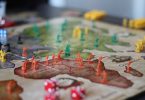Dr Black, the host of a small party held at a magnificent Tudor Mansion, has been found dead in the basement. The only possible suspects are his six guests: Mrs Peacock, the Reverend Green, Professor Plum, Miss Scarlett, Colonel Mustard, and Mrs White. Could you solve the mystery by identifying the scene of the crime, the murder weapon, and the killer?
Cluedo - the Classic Mystery Board Game
This is the challenge posed to players of Cluedo, one of the world’s most popular board games. A family favourite ever since its launch in 1943, the game offers a series of benefits to young and old alike. As they tour the mansion together while investigating the crime, players develop skills of strategy, deduction, and communication, competing with their friends and family to catch the killer and emerge victorious as the champion detective!
Interested in joining the detective mission? Before we throw the first dice, let’s learn a little more about the tabletop classic. As ever, we’ve got it all covered for you. Read on for everything you wanted to know about Cluedo!
Setting the Scene (of the Crime!)

Cluedo is a murder mystery game played by three to six players. It was created in 1943 by Anthony E. Pratt, a solicitor’s clerk from Birmingham. His Cluedo was based on a parlour game he played with his wife and their friends – allegedly inspired by a famous Tudor mansion hotel in Rottingdean, Brighton. Pratt sold the patent to Waddingtons, a leading manufacturer of card and board games.
The war years delayed commercial production of the game, so the first edition did not hit the shops until 1949. Since then, it has been relaunched many times in many different versions, and is currently produced worldwide by Hasbro, the American toy company.
Cluedo was derived from a classic murder mystery scenario explored by many English authors – perhaps most famously by Arthur Conan Doyle and Agatha Christie. From Sherlock Holmes to Poirot, sleuths have wrestled with the problem of a range of characters isolated in an English country house: one is murdered, “who dunnit”? In the Cleudo version, there are six possible murderers, six possible weapons, and nine possible rooms to serve as the crime scene. Players have to deduce who was the killer, which weapon was used, and where the murder took place. The first player to solve the mystery is the winner!
What’s in the box?

When you buy the classic Cluedo you become the proud owner of all the components needed to play the game:
- The Cluedo game board showing a plan view of nine rooms on the ground floor of an English country house, typically including the Hall, Lounge, Dining Room, Kitchen, Ballroom, Conservatory, Billiard Room, Library, and Study.
- Six character tokens representing the suspects: Mrs Peacock, The Reverend Green, Professor Plum, Miss Scarlett, Colonel Mustard, and Mrs White.
- Six murder weapons: usually the Revolver, Dagger, Lead Piping, Rope, Spanner, and Candlestick.
- Dice: at the start of their turn, a player rolls a pair of dice and, depending on their score, moves from room to room along a tiled floor.
- Case File envelope: the three cards representing the solution to the mystery are kept out of sight in this envelope.
- 21 playing cards, comprising six weapon cards, six character cards, and nine room cards, one for each room on the board.
- Detective notebook: each player has their own notebook in which they keep a record of any clues which will help them solve the mystery.
Setting up the game board

- The six character tokens are placed on designated squares on the game board.
- Each of the six weapons is placed at random in one of the nine rooms.
- The playing cards are separated into three groups: Characters, Weapons and Rooms.
- Each group is shuffled face-down, and one card is drawn from each group and placed into the Case File envelope. These three cards represent the solution to the mystery – the identity of the murderer, the weapon used, and where the murder was committed. The envelope is placed in the centre of the game board.
- The 18 remaining cards are shuffled together and dealt face down to the players.
How to Play
It all starts with the narrative – a classic murder mystery. Reclusive professor Dr Black hosts a party for six guests. Sometime during the evening, the butler finds Dr Black dead in the basement. It is clear that the butler did not commit the murder, and that it did not take place in the basement. The only possible suspects are the six guests. The task of the players is to determine which of the guests committed the crime, with which weapon, and in which room.
Each player has been dealt a hand of three, four, five or six cards, the number being dependent on the number of players. They know that the cards in their hand cannot be in the Case File envelope, so they can eliminate these cards from the list of suspects. They note this in their Detective notebooks. Now they have to eliminate the remaining cards one by one until they are left with just the three which represent the murderer, the weapon, and the room.
The player sitting closest to the Miss Scarlett token starts the game. In a turn, a player throws a set of dice, and they can then move their character token that number of steps across the tiled floor.
If they enter a room, they may ask their fellow players a question to eliminate one of their suspicions. All questions consist of a murder suspect, a weapon, and the room the token is currently in.
Each player is then asked if they have one of the cards under suspicion. If they have none of these cards, the next player in turn is asked this same question. If they have one of the cards they have to show it to the player who asked the question without letting the other players see it.
If no cards are revealed by any of the players, you can then make an accusation that these three cards represent the solution to the mystery. You write the accusation in your detective notebook, and look in the envelope. If your accusation is correct … hooray! … you have won the game!
But you can only make one accusation per game, so you should hold back until you are certain you know what is in the envelope. If you make a false accusation your only role in the game will be to answer the questions of the other players.
Tips for Beginner Detectives

- Mrs Peacock has a slight advantage at the start of the game as she sits closer to a room than any other character.
- Moving from room to room as fast as possible can increase your chances of winning, as there are more rooms to eliminate than there are characters or weapons.
- Use the secret passages to move quickly from one corner to another.
- Include the cards in your own hand in some suggestions to mislead the other players.
- Be careful not to help your opponent by moving their character token into a remote room to make them the subject of your question. If there’s another character you can base your question on, eliminate that one first.
- Make as many notes as possible in your Detective notebook: which cards you have in your hand; which cards are held by which player; even which cards are NOT held by each player!
Tips for Improving Players
- Notetaking: as a player becomes more skilful the amount of detail in the notes that they make will increase. Beginners will be limited to ticking off the cards they have been shown by the other players, but they will soon progress to keeping track of the cards held by each player, often using their own coded shorthand to store the information.
- Advanced players will record each question asked, knowing that a player who responds positively must have at least one of the named cards. Notes can also be made on which cards a player has been shown, in order to glean insights into that player’s questions.
- Creating the question: There several ways to form the question a player asks when they get their turn. The simplest way is to look at your notes to see which cards in each category have not yet been eliminated, and pick three at random to create your question.
- Another idea is to use one of your own cards in the question, to focus on getting information on a particular category.
- Responding to the question:
- If you are asked to answer the question then if you have one or more of the cards queried you have to show one of them.
- If you have only one of the cards, then you have no choice, and you have to show that one.
- When you have more than one, there are different strategies that can be used. While beginners will simply choose one of the cards at random, a slightly more complicated strategy is to check whether you have already shown one of the cards to the querying player. If so, then just show that card again, giving them no new information. If you haven’t yet shown any of the cards to the questioner, then just choose a random card.
- A further enhancement to your response strategy comes into play when you have more than one of the cards in the question, and have not yet shown either of them to the other player. In this case, you want the other player to gain the least amount of information. A way to do this is to consider how much information showing either of these cards would give your opponent.
- If you think that they know almost all of the weapon cards, you would be better off to show a character card. However, if there are six possible weapons and four possible suspects, it might be better to show a weapon, because that would give relatively less information.
- Making an accusation: here there are a few things to consider. On the one hand, you want to wait until you are certain about the three cards which will win you the game, and a mistake at this stage would mean that you lose immediately. But sometimes you know all the cards in the envelope, except for one, which still has two possibilities. It’s your turn, do you make an accusation now, or wait until your next turn, when you might have gained the missing information? In these circumstances, with all the other players having an opportunity to make an accusation before your turn arrives again, it could be a good strategy to simply guess the remaining card. Do you think the other players are at the same stage as you? The decision is yours!
The Benefits of Playing Cluedo
- Board games such as Cluedo promote quality family time, helping different generations to enjoy each other’s company in a fun environment. As a much-loved classic, it is very likely that grandparents will have played Cluedo in their youth, and can teach the kids a thing or two about how to solve the mystery!
- Although it is a fairly simple game to play, and is recommended for anyone aged 8 and older, Cluedo requires children to understand and apply relatively complex instructions.
- Communication skills are developed by the requirement both to pose coherent questions and to respond to such questions when asked. The fundamental importance of communication makes the game ideal for boosting children’s language and speech skills. Government communications adviser Jean Gross said: “Cluedo is really good because it involves speculating. What we often want with language is to get children not just talking about the here and now, but about what might be.”
- Cluedo encourages healthy competition and the celebration of each other’s successes, teaching children how to respond constructively to both winning and losing. Not always an easy task – as most parent would agree!
- Cluedo develops the ability to concentrate, as players have to keep track of all questions and answers made by the other players in the game rather than allowing themselves to be distracted when it is not their own turn to play.
- The game is especially effective at teaching deductive reasoning skills, enhancing the development of general problem-solving skills.
Cluedo Versions
Cluedo provides lots of scope for new versions. The most popular of these are spinoffs from films or TV series, and some are designed to remove the murder element for young children with the mystery being based of a lost item or a missing character who has to be found.
- Cluedo Junior: players have to solve the mystery of the missing slice of cake. Who took a piece of the cake before dinner? When was it taken? What did they drink with it?
- Harry Potter: a friend has disappeared. Playing Harry, Ron, Hermione, Ginny, Luna or Neville, players must discover who was responsible, what spell was used, and where the victim was attacked.
- Cluedo Sherlock Edition: Sherlock and Watson appear in 21st century London. Who killed Moriarty?!
- Other popular versions have been based on Charlie and the Chocolate Factory, Star Wars, A Game of Thrones, The Simpsons, The Office, and a host of others.
Fun Facts
- In the USA the game is called ‘Clue’ instead of Cluedo
- In 1993 Peter DePietro and Tom Chiodo of the Manhattan Rep Company promoted a Clue world championship in New York City. Part competition and part performance art, contestants played while interacting with actors dressed as Clue characters.
- Standard Cluedo provides 324 different combinations of murderer, weapon and room, so there are 324 possible solutions to the mystery.
- Numerous games, books, television series, a film, and a musical have been released as part of the Cluedo franchise.
- Several spinoffs have been released featuring alternative characters, weapons and rooms, or changes to the rules of the game.
- The original Cluedo game is marketed as “The Classic Detective Game”, and the spinoffs are all distinguished by their own individual slogans.
Who’s Who?
- In Norway, Mrs. Peacock is called Baroness von Blauw, but in Spain she’s Capitano Azurro, a man! And Colonel Mustard is known to the Swiss as Madam Curry!
- In Germany, the exotic Miss Scarlet is called Fraulein Ming. In Switzerland she has a more ordinary name, Evelyne Rose, but she does have the distinction of being the only Cluedo character whose card includes a first name!
- Spanish players call Professor Plum, Dr Mandarino, and the Swiss call him Docteur Dunkel!
- And what of our resident corpse, named Dr Black by his English creators? In the USA he’s Mr Boddy; in Spain, he’s Dr Lemon; in Switzerland, either Herr Kludo or Monsieur Cluedo, depending on which part of the country you’re in. But Hasbro have reserved the most appropriate moniker for a Spanish version of the game … Señor Cadaver!
Cluedo in films and popular culture
- In the film Toy Story 2 (2009), when Hamm is trying to find clues as to how to find Woody he is standing on the board game Clue.
- ‘Cluedo’ was an ITV game show which ran from 1990 to 1993. In each episode the murder of a visiting guest at Arlington Grange was re-enacted, and by questioning the suspects and using their powers of deduction, celebrity guests had to discover who committed the murder, which of six weapons was used, and in which room it was committed.
- An American film, ‘Clue’, released in 1985, is a black comedy mystery based on the board game. It featured three different endings, with each cinema receiving just one of the three possible endings. Subsequent home media releases included all three endings presented sequentially. Initially the film was poorly received but later it developed a considerable cult following.
- The highly acclaimed 2019 film ‘Knives Out’, starring Daniel Craig, was nominated for several major film awards. It is considered to be inspired by the works of Agatha Christie and Cluedo!
Conclusion
If you want some family fun, and a chance to don the detective cap and play Sherlock, look no further than this classic staple of family entertainment. Cluedo games are quick to play, simple enough for children to master, and still great fun after all these years!







